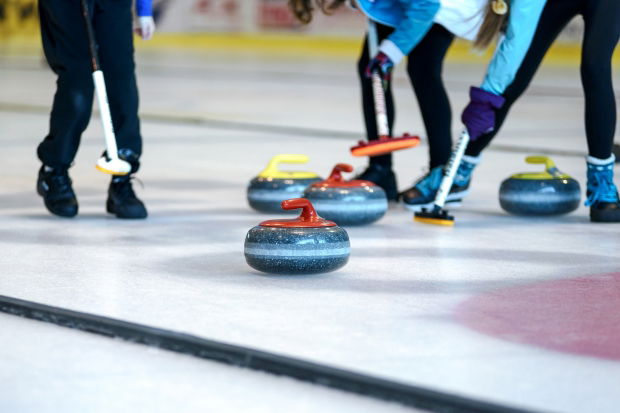CIURLING

WHAT IS CURLING?
Curling, a game similar to lawn bowls but played on ice. Two teams of four players (given the titles lead, second, third, and skip) participate in a curling match. Each player slides round stones, concave on the bottom and with a handle on the top, across the ice of a rink or a natural ice field toward the tee, or button, which is a fixed mark in the center of a circle (called the house) marked with concentric bands. The object of the game is for each side to get its stones closest to the center. Two teams, each with four players, take turns sliding heavy, polished granite stones, also called rocks, across the ice curling sheet toward the house, a circular target marked on the ice. Each team has eight stones, with each player throwing two. The purpose is to accumulate the highest score for a game; points are scored for the stones resting closest to the center of the house at the conclusion of each end, which is completed when both teams have thrown all of their stones. A game usually consists of eight or ten ends. Two teams, each with four players, take turns sliding heavy, polished granite stones, also called rocks, across the ice curling sheet toward the house, a circular target marked on the ice. Each team has eight stones, with each player throwing two. The purpose is to accumulate the highest score for a game; points are scored for the stones resting closest to the center of the house at the conclusion of each end, which is completed when both teams have thrown all of their stones. A game usually consists of eight or ten ends.
HISTORY
The word curling first appears in print in 1620 in Perth, Scotland, in the preface and the verses of a poem by Henry Adamson. The sport was (and still is, in Scotland and Scottish-settled regions like southern New Zealand) also known as "the roaring game" because of the sound the stones make while traveling over the pebble (droplets of water applied to the playing surface). The verbal noun curling is formed from the Scots (and English) verb curl, which describes the motion of the stone. Curling is associated especially with Scotland, where the game dates to the early 16th century. Paintings by Pieter Bruegel the Elder dating from about the same time are evidence that the game was also played in the Low Countries, but it was Scotland that promoted the game worldwide. The Grand Caledonian Curling Club was organized at Edinburgh in 1838 (royal patronage made it the Royal Caledonian Curling Club in 1843) with the announced purpose of becoming an international body. The International Curling Federation was founded there in 1966. The game is similar to bowls and shuffleboard. It is a team sport, played by two teams of four players. Teams take turns sliding the stones down the ice towards the target. The target is segmented into four concentric circles. Each of the four players will alternately slide heavy and polished granite stones, which are also called rocks, across the ice curling sheet. 토토사이트
